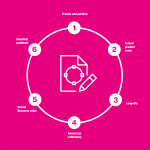Total Quality Management (TQM) is a structured system for satisfying internal and external customers and suppliers by integrating the business environment, continuous improvement, and breakthroughs with development, improvement, and maintenance cycles while changing organizational culture. TQM aims for quality principles to be applied broadly throughout an organization or set of business processes. Total Quality Management (TQM) programs focus on improvement in individual operations with unrelated processes; as a consequence, it takes many years before all operations within a given process are improved. Six Sigma focuses on making improvements in all operations within a process that produce results more rapidly and effectively.
The Six Sigma’s Breakthrough Strategy is a disciplined method of using extremely rigorous data-gathering and statistical analysis to pinpoint sources of errors and ways of eliminating them. Six Sigma relies on the voice of the consumer to set the standard of acceptable performance. Six Sigma has a systematic approach to both validate data and to focus on the critical few inputs that will have the greatest potential to effect meaningful improvement.
Six Sigma focuses on reducing defects in management and clinical process; it uses statistical analysis to find the most defective part of the process, and rigorous control procedures to sustain improvement.
While Six Sigma is a long-term strategy, it is designed to generate immediate improvements to profit margins too. Compared to traditional quality management programs such as TQM that project three or more years into the future, Six Sigma focuses on achieving financial targets in twelve-month increments.
TQM and Six Sigma have a number of similarities including the following:
1. A customer orientation and focus
2. A process view of work
3. A continuous improvement mindset
4. A goal of improving all aspects and functions of the organizations
5. Data based decision-making
6. Benefits depend highly on effective implementation
A key difference between TQM and Six Sigma is that Six Sigma focuses on prioritizing and solving specific problems which are selected based on the strategic priorities of the company and the problems which are causing the most defects whereas TQM employs a more broad based application of quality measures to all of the company’s business processes. Another difference is that TQM tends to apply quality initiatives within specific departments whereas Six Sigma is cross-functional meaning that in penetrates every department, which is involved in a particular business process that is subject to a Six Sigma project.
Another difference TQM provides less methodology in terms of the deployment process whereas Six Sigma’s DMAIC framework provides a stronger platform for deployment and execution. For example, Six Sigma has a much stronger focus on measurement and statistics, which helps the company, define and achieve specific objectives. Six Sigma is complementary to TQM because it can help to prioritize issues within a broader TQM program and provides the DMAIC framework, which can be used to meet TQM objectives.
Conclusion
Both measurements of quality control within an organization have brought true success to companies who have applied their policies and procedures.
The leaders and management teams of any organization will have to evaluate which quality of control tactic is the most beneficial to the growth and improvements of their business.
The one way to analyze your business is to establish your goals and vision for your organization and set plans in place to evaluate if Six Sigma or Total Quality Management falls in the realms of what you are seeking.
Both processes have taken the best of the best countries and companies from good to great and I personally feel that as long as you have one of these processes in place, you are setting yourself up for success.
.

93,063 Comments
synthroid cost generic
Hey! Someone in my Facebook group shared this site
with us so I came to check it out. I’m definitely loving the
information. I’m book-marking and will be tweeting this to my followers!
Terrific blog and great design and style.
This design is spectacular! You obviously know how to keep a reader entertained.
Between your wit and your videos, I was almost moved to start my
own blog (well, almost…HaHa!) Great job. I really loved what you had to say,
and more than that, how you presented it. Too cool!
一言にロリータ系のラブドールと言っても、セックス ロボット様々なタイプが販売されています ?今回はロリータ系ラブドールのそれぞれの違いを比較して解説したいと思います。
I am truly pleased to read this webpage posts which contains tons of valuable information,
thanks for providing such information.
Having read this I believed it was very informative.
I appreciate you finding the time and energy to put this informative article together.
I once again find myself personally spending a significant
amount of time both reading and commenting.
But so what, it was still worth it!
психологи москва w-495.ru
Whoa! This blog looks just like my old one! It’s on a
entirely different topic but it has pretty much the
same page layout and design. Great choice of colors!
It is in point of fact a nice and useful piece of info.
I’m glad that you shared this useful info with us. Please keep us informed like
this. Thank you for sharing.
I was very pleased to discover this site. I wanted to thank you
for your time due to this fantastic read!! I definitely enjoyed every bit of
it and I have you book-marked to see new stuff in your site.
For enthusiasts of WoW, Wowhjead is your ultimate destination for all things concerning the game.
From in-depth walkthroughs on the most challenging quests to the latest news onn expansions and updates, Wow Head has it all.
Very energetic article, I loved that a lot. Will there be a part
2?
Here is my blog post … small business marketing